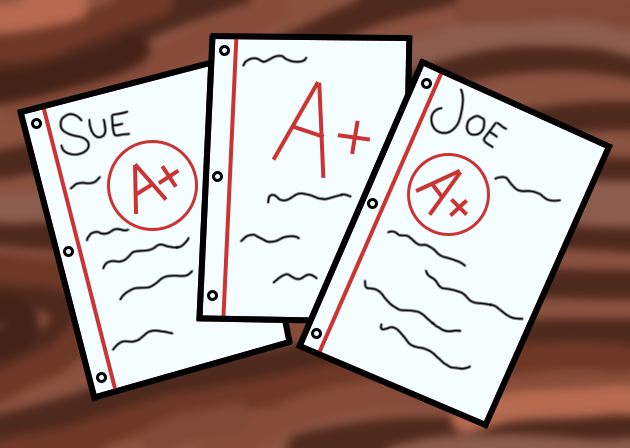Grade inflation: an affliction of high schools across the nation
In a 2018 study from the Thomas B. Fordham Institute, researchers studying North Carolina high schools found that while high school GPAs have risen, SAT, ACT, and other standardized test scores have stagnated. Other researchers have observed this occurrence in other states, concluding that grade inflation, a phenomenon in which grades climb over the years due to lowered standards, is rampant across the country.
Grade inflation must be reversed nationwide.
In my sophomore year, I took American Literature, a class both revered and feared in part for its difficult grading standards. While I was used to getting good grades in other classes, in this class, it wasn’t uncommon to receive a B for the amount of effort that would have merited a high A in others. Instead of discouraging me, the increased difficulty enabled me to go beyond what I had learned before, and I enjoyed it. Likewise, I saw classmates who typically aced other classes be challenged in a way that stimulated their intellectual growth.
Isn’t this what we want in our schools?
Without grade inflation, students would be encouraged to acquire true knowledge, gaining the ability to reason and apply what they know, rather than to learn for the sake of passing tests. It should not be possible for students to achieve a perfect score simply by studying the tested material; schools are supposed to incentivize learning for the sake of learning, not crammed learning for the sake of acing a test.
Currently, we have the following case: Sue loves biology and goes the extra mile in studying, truly delving into the subject matter. Joe, on the other hand, crams the night before, learning exactly what he needs to know for the test, having teased out from the teacher as much information about the test as possible beforehand. Both students receive perfect scores; however, Sue has a better grasp of the material and can reason within its bounds rather than simply parrot what she was “supposed to know.” Based on the grades, there is no difference between Sue and Joe.
Some are fine with this system because they argue that this is the most efficient and logical way to study in a world where many students participate in extracurriculars that take up a lot of time, but this is simply not true. Many experts, including UCLA psychologist Robert Bjork, have found cramming to be highly ineffective for long-term retention and have spoken out against it, deeming long-term learning methods as superior. If the only way a student can study is by cramming, they should drop some of their extracurricular activities.
“Okay, fine,” the cramming supporters say, “but students can’t give up their extracurriculars! How else will they stand out to colleges?”
Students could give them up if it weren’t for grade inflation. Grade inflation forces students to load up on extracurriculars since without them, a student’s good grades don’t hold water on the national scale.
Students like Sue load up on activities to stay competitive in the college sphere but often begin to spend less and less time learning and studying to keep up with the demand of their activities. Since Joe gets a gold star doing so little, Sue finds a way to follow suit. Year by year, the students become more and more bogged down by commitments, leaving less and less time for their books. Learning diminishes, but grades remain high. It is in this way that institutions whose mission it is to encourage intellectual exploration and understanding end up becoming gold star distribution centers which create people whose only care is to remember what to know, when to know it, and how to think.
Finally, perfect scores must be nearly impossible to receive. Perfect scores create a sense of complacency in top-scoring students. To tell a teenager that they have done a perfect job is to tell them that they can stop right there. To convey this message to masses of teenagers is to potentially create a generation full of self-satisfied people who never reach their potential.
100 percent means perfection. It means a state in which there is no more room to improve. However, this hackneyed score has lost its worth. To fix this, schools nationwide need to increase their grading standards. Of course, this is easier said than done. Curriculums need to be adjusted, criteria for high grades need to be redefined, and so on, but without a national movement towards deflated grades, America will become a place where learning and cramming are synonymous, where everyone gets a trophy, and where report cards become more and more meaningless.

